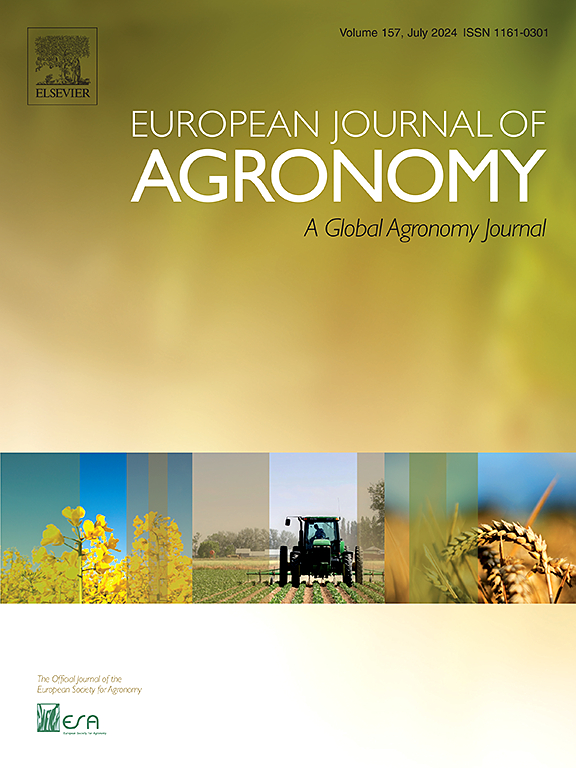资源有效度对比下玉米植株等级间生物量向顶穗分配的时间格局
IF 4.5
1区 农林科学
Q1 AGRONOMY
引用次数: 0
摘要
大多数关于玉米(Zea mays L.)的研究都集中在籽粒结实关键时期(从- 220 +100°Cd开始;R1)。然而,早建立的株际生长变异(V7左右)在此期间影响植株和穗的生长,影响植株等级间的籽粒结实。丝挤压的延迟通常与R1之前植物生长缓慢导致的BAE减少有关。本研究考察了植物之间的BAE和热时间(TT)对R1的变异性是否在周期的早期被预先调节(接近V7)。在不同的林分密度(9株和12株m - 2)、氮素水平(0和200 kg N ha - 1)或水分利用(丰水和亏水)组合条件下,对拥挤胁迫耐受性不同的两个玉米杂交种(AX820:高,AX877:低)进行了田间栽培。在R1后的V7 ~ 100°Cd处取样,将植株分为优势、中间和优势三个层次。对于每个层次,BAE估计为穗生物量与植株生物量的比值。非生物胁迫增加了植株间变异,降低了生长和BAE,延迟了TT到R1的时间。利用播种对BAE与TT自然对数线性回归的方差分析,分析了不同植物等级间BAE模式的差异。优势植株对R1的TT时间较长,这是由于活性BAE延迟发作所致。当TT与R1在每个层次上对齐时,出现了常见的BAE模式,表明对BAE有个体效应。本文章由计算机程序翻译,如有差异,请以英文原文为准。
Temporal pattern of biomass partitioning to apical ear in maize plant hierarchies under contrasting resource availabilities
Most studies in maize (Zea mays L.) focus on biomass partitioning to the ear (BAE) during the critical period for kernel setting (from −220 +100°Cd from silking; R1). However, early-established interplant variability of growth (around V7) affects both plant and ear growth during this period, influencing kernel setting across plant hierarchies. Delays in silk extrusion are often linked to reduced BAE due to low plant growth just before R1. This study examined whether variability of BAE and thermal time (TT) to R1 among plants is pre-conditioned early in the cycle (close V7). Two maize hybrids with contrasting tolerance to crowding stress (AX820: high, AX877: low) were grown in field conditions under combinations of stand densities (9 and 12 plants m−2) and nitrogen levels (0 and 200 kg N ha−1) or water availabilities (well-watered and water deficit). Plants were sampled from V7 to 100°Cd after R1 and classified into dominant, intermediate, and dominated hierarchies. For each hierarchy, BAE was estimated as the ratio of ear biomass to plant biomass. Abiotic stresses increased interplant variability, reduced growth and BAE, and delayed TT to R1. Differences on BAE patterns among plant hierarchies were analyzed using ANOVA of linear regressions of natural log of BAE vs TT from sowing. Dominated plants showed longer TT to R1 due to a delayed onset of active BAE. A common BAE pattern emerged when TT was aligned with R1 for each hierarchy, suggesting an ontogenic effect on BAE.
求助全文
通过发布文献求助,成功后即可免费获取论文全文。
去求助
来源期刊

European Journal of Agronomy
农林科学-农艺学
CiteScore
8.30
自引率
7.70%
发文量
187
审稿时长
4.5 months
期刊介绍:
The European Journal of Agronomy, the official journal of the European Society for Agronomy, publishes original research papers reporting experimental and theoretical contributions to field-based agronomy and crop science. The journal will consider research at the field level for agricultural, horticultural and tree crops, that uses comprehensive and explanatory approaches. The EJA covers the following topics:
crop physiology
crop production and management including irrigation, fertilization and soil management
agroclimatology and modelling
plant-soil relationships
crop quality and post-harvest physiology
farming and cropping systems
agroecosystems and the environment
crop-weed interactions and management
organic farming
horticultural crops
papers from the European Society for Agronomy bi-annual meetings
In determining the suitability of submitted articles for publication, particular scrutiny is placed on the degree of novelty and significance of the research and the extent to which it adds to existing knowledge in agronomy.
 求助内容:
求助内容: 应助结果提醒方式:
应助结果提醒方式:


